Related Research Articles

Dentistry, also known as dental medicine and oral medicine, is the branch of medicine focused on the teeth, gums, and mouth. It consists of the study, diagnosis, prevention, management, and treatment of diseases, disorders, and conditions of the mouth, most commonly focused on dentition as well as the oral mucosa. Dentistry may also encompass other aspects of the craniofacial complex including the temporomandibular joint. The practitioner is called a dentist.
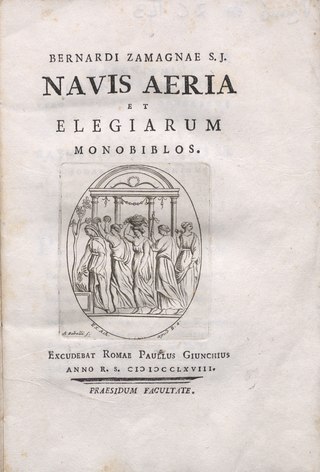
The year 1768 in science and technology involved some significant events.

Dentures are prosthetic devices constructed to replace missing teeth, supported by the surrounding soft and hard tissues of the oral cavity. Conventional dentures are removable. However, there are many denture designs, some of which rely on bonding or clasping onto teeth or dental implants. There are two main categories of dentures, the distinction being whether they fit onto the mandibular arch or on the maxillary arch.
Cosmetic dentistry is generally used to refer to any dental work that improves the appearance of teeth, gums and/or bite. It primarily focuses on improvement in dental aesthetics in color, position, shape, size, alignment and overall smile appearance. Many dentists refer to themselves as "cosmetic dentists" regardless of their specific education, specialty, training, and experience in this field. This has been considered unethical with a predominant objective of marketing to patients. The American Dental Association does not recognize cosmetic dentistry as a formal specialty area of dentistry. However, there are still dentists that promote themselves as cosmetic dentists.

A bridge is a fixed dental restoration used to replace one or more missing teeth by joining an artificial tooth definitively to adjacent teeth or dental implants.
Dental restoration, dental fillings, or simply fillings are treatments used to restore the function, integrity, and morphology of missing tooth structure resulting from caries or external trauma as well as to the replacement of such structure supported by dental implants. They are of two broad types—direct and indirect—and are further classified by location and size. A root canal filling, for example, is a restorative technique used to fill the space where the dental pulp normally resides.

A dental technician is a member of the dental team who, upon prescription from a dental clinician, constructs custom-made restorative and dental appliances.

Dental porcelain is a dental material used by dental technicians to create biocompatible lifelike dental restorations, such as crowns, bridges, and veneers. Evidence suggests they are an effective material as they are biocompatible, aesthetic, insoluble and have a hardness of 7 on the Mohs scale. For certain dental prostheses, such as three-unit molars porcelain fused to metal or in complete porcelain group, zirconia-based restorations are recommended.

A dental implant is a prosthesis that interfaces with the bone of the jaw or skull to support a dental prosthesis such as a crown, bridge, denture, or facial prosthesis or to act as an orthodontic anchor. The basis for modern dental implants is a biological process called osseointegration, in which materials such as titanium or zirconia form an intimate bond to the bone. The implant fixture is first placed so that it is likely to osseointegrate, then a dental prosthetic is added. A variable amount of healing time is required for osseointegration before either the dental prosthetic is attached to the implant or an abutment is placed which will hold a dental prosthetic/crown.

In dentistry, a crown or a dental cap is a type of dental restoration that completely caps or encircles a tooth or dental implant. A crown may be needed when a large dental cavity threatens the health of a tooth. Some dentists will also finish root canal treatment by covering the exposed tooth with a crown. A crown is typically bonded to the tooth by dental cement. They can be made from various materials, which are usually fabricated using indirect methods. Crowns are used to improve the strength or appearance of teeth and to halt deterioration. While beneficial to dental health, the procedure and materials can be costly.
Prosthodontics, also known as dental prosthetics or prosthetic dentistry, is the area of dentistry that focuses on dental prostheses. It is one of 12 dental specialties recognized by the American Dental Association (ADA), Royal College of Surgeons of England, Royal College of Surgeons of Edinburgh, Royal College of Surgeons of Ireland, Royal College of Surgeons of Glasgow, Royal College of Dentists of Canada, and Royal Australasian College of Dental Surgeons. The ADA defines it as "the dental specialty pertaining to the diagnosis, treatment planning, rehabilitation and maintenance of the oral function, comfort, appearance and health of patients with clinical conditions associated with missing or deficient teeth or oral and maxillofacial tissues using biocompatible substitutes."

In dentistry, inlays and onlays are used to fill cavities, and then cemented in place in the tooth. This is an alternative to a direct restoration, made out of composite, amalgam or glass ionomer, that is built up within the mouth.
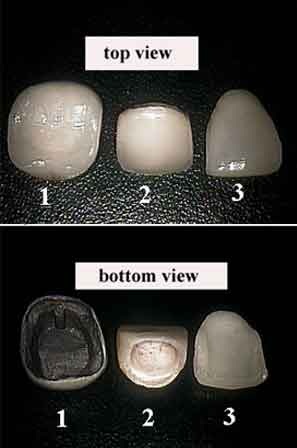
In dentistry, a veneer is a layer of material placed over a tooth. Veneers can improve the aesthetics and function of a smile and protect the tooth's surface from damage.
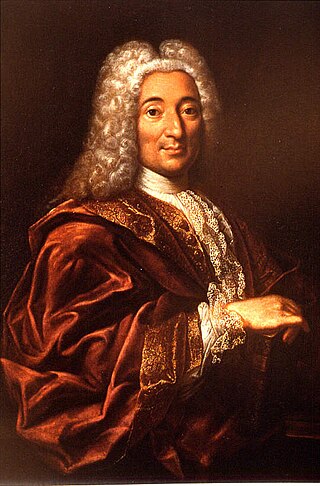
Pierre Fauchard was a French physician, credited as being the "father of modern dentistry". He is widely known for writing the first complete scientific description of dentistry, Le Chirurgien Dentiste, published in 1728. The book described basic oral anatomy and function, signs and symptoms of oral pathology, operative methods for removing decay and restoring teeth, periodontal disease (pyorrhea), orthodontics, replacement of missing teeth, and tooth transplantation.
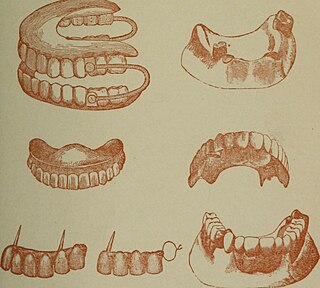
A denturist in the United States and Canada, clinical dental technologist in the United Kingdom and Ireland, dental prosthetist in Australia, or a clinical dental technician in New Zealand is a member of the oral health care team and role as primary oral health care provider who provides an oral health examination, planning treatment, takes impressions of the surrounding oral tissues, constructs and delivers removable oral prosthesis treatment directly to the patient.
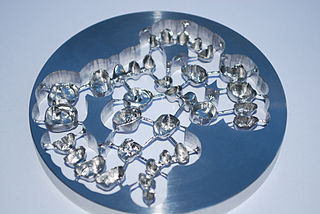
CAD/CAM dentistry is a field of dentistry and prosthodontics using CAD/CAM to improve the design and creation of dental restorations, especially dental prostheses, including crowns, crown lays, veneers, inlays and onlays, fixed dental prostheses (bridges), dental implant supported restorations, dentures, and orthodontic appliances. CAD/CAM technology allows the delivery of a well-fitting, aesthetic, and a durable prostheses for the patient. CAD/CAM complements earlier technologies used for these purposes by any combination of increasing the speed of design and creation; increasing the convenience or simplicity of the design, creation, and insertion processes; and making possible restorations and appliances that otherwise would have been infeasible. Other goals include reducing unit cost and making affordable restorations and appliances that otherwise would have been prohibitively expensive. However, to date, chairside CAD/CAM often involves extra time on the part of the dentist, and the fee is often at least two times higher than for conventional restorative treatments using lab services.
Fixed prosthodontics is the branch of prosthodontics that focuses on dental prostheses that are permanently affixed (fixed). Crowns, bridges, inlays, onlays, and veneers are some examples of indirect dental restorations. Prosthodontists are dentists who have completed training in this specialty that has been recognized by academic institutes. Fixed prosthodontics can be used to reconstruct single or many teeth, spanning tooth loss areas. The main advantages of fixed prosthodontics over direct restorations are improved strength in big restorations and the possibility to build an aesthetic-looking tooth. The concepts utilised to select the suitable repair, as with any dental restoration, include consideration of the materials to be used, the level of tooth destruction, the orientation and placement of the tooth, and the condition of neighboring teeth.
Adhesive dentistry is a branch of dentistry which deals with adhesion or bonding to the natural substance of teeth, enamel and dentin. It studies the nature and strength of adhesion to dental hard tissues, properties of adhesive materials, causes and mechanisms of failure of the bonds, clinical techniques for bonding and newer applications for bonding such as bonding to the soft tissue. There is also direct composite bonding which uses tooth-colored direct dental composites to repair various tooth damages such as cracks or gaps.

Newell Sill Jenkins was an American dentist who practiced most of his life in Dresden, Germany. He developed and improved the Jenkins porcelain enamel, thus making a composition of porcelain paste into porcelain inlays, dental crowns and bridges. He is thus the founder of aesthetic dentistry.
The history of dental treatments dates back to thousands of years. The scope of this article is limited to the pre-1981 history.
References
- 1 2 3 4 5 6 Giuseppangelo Lucinto Fonzi entry (in Italian) by Luciano Bonuzzi in the Enciclopedia italiana , 1997
- 1 2 3 4 Andrea Santamaría. Giuseppangelo Fonzi, inventor de los dientes de Porcelana (PDF) (in Spanish). Universidad Complutense Madrid. Retrieved 2021-03-02.
- 1 2 3 4 5 6 Alicia Celemín Viñuela (18 June 2009). "Giuseppangelo Fonzi: su gran aportación a la materia de prótesis dentaria". Gaceta Dental. Retrieved 2021-03-02.
- ↑ Dubois de Chémant, Nicolas (1788). Dissertation sur les avantages des nouvelles dents et rateliers artificiels, incorruptibles et sans odeur (in French). Paris: Gattey. Retrieved 2021-03-02.
- 1 2 "L'Aventure des dents minérales". biusante.parisdescartes.fr. Association de sauvegarde du patrimoine de l'art dentaire (ASPAD). Retrieved 2021-03-02.
- ↑ "Giuseppangelo Fonzi (1768-1840)". data.bnf.fr. Bibliothèque nationale de France (BnF). 2021-01-14. Retrieved 2021-03-02.
- ↑ Salim Badre Asbia; Mahesh Suganna; Jothikumar Kamalakkanan; Jilani Saafi (2020). "Dental ceramic in prosthetic dentistry: historical development". African Journal of Dentistry & Implantology. 17. Retrieved 2021-03-02.
- 1 2 3 4 5 B. Kurdyk (July 1999). "Giuseppangelo Fonzi: industrial fabrication promoter of porcelain prosthetics". Journal of the History of Dentistry. 47 (2): 79–82. ISSN 1089-6287. PMID 10686916. Archived from the original on 2021-07-17. Retrieved 2021-03-02.